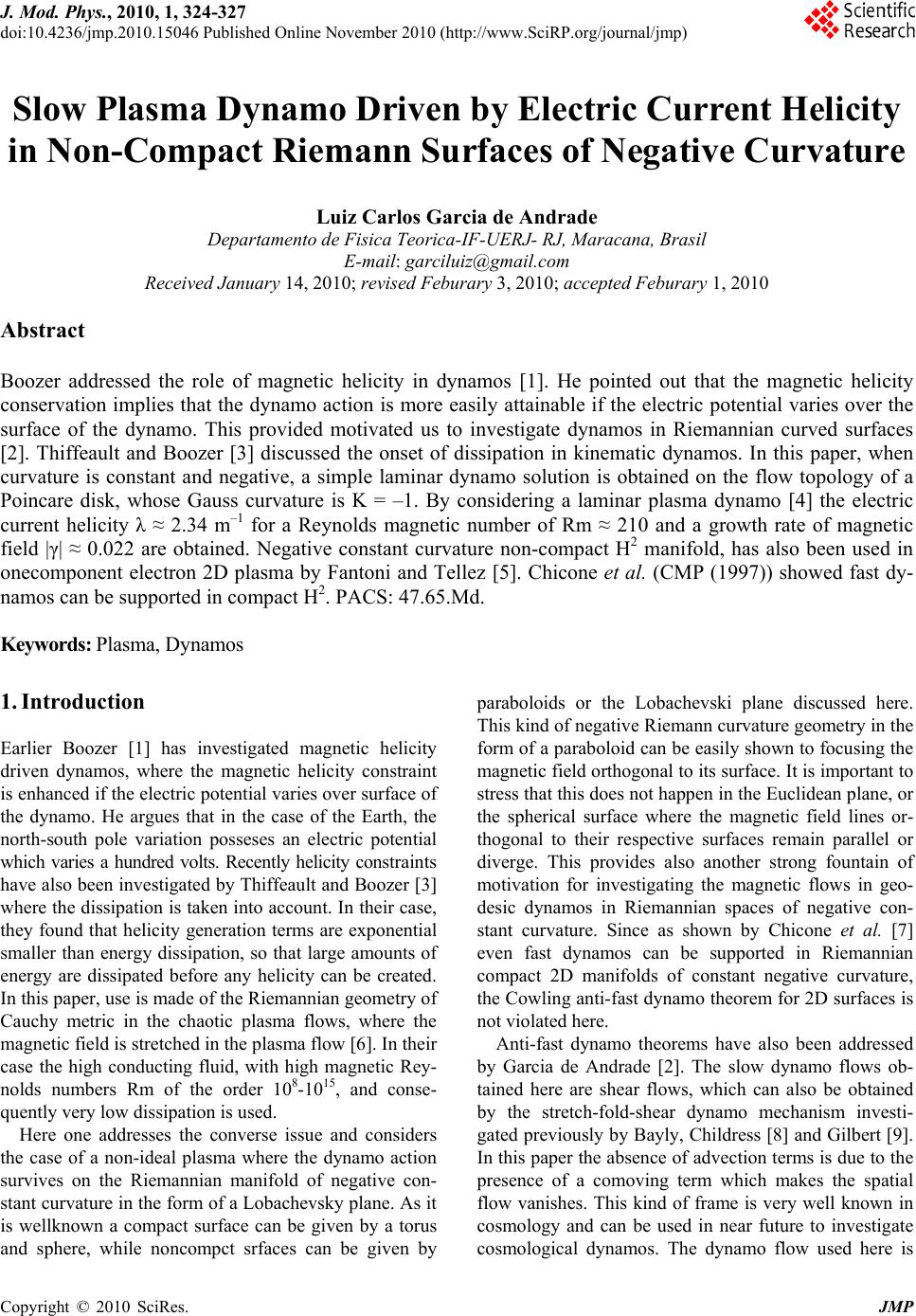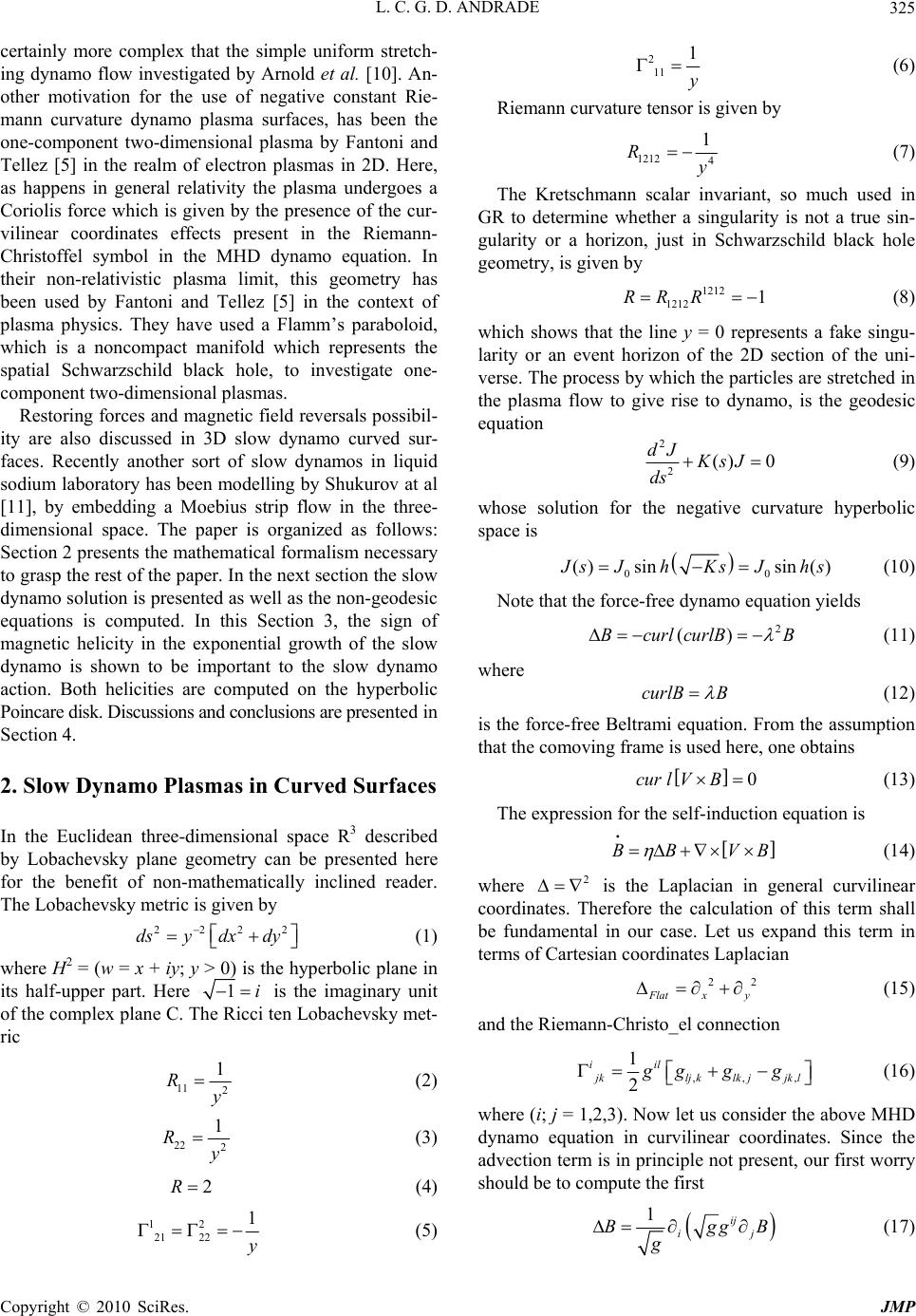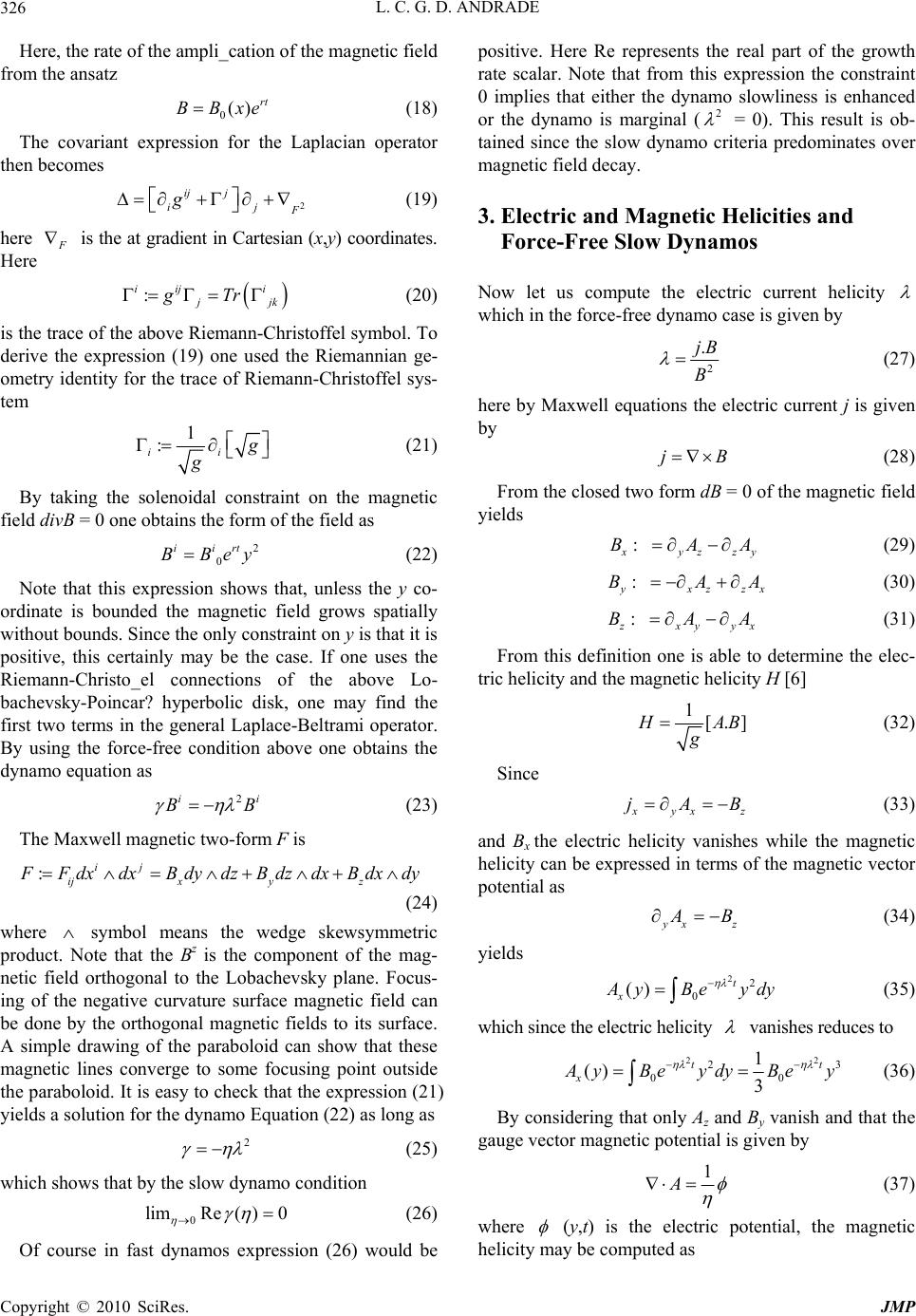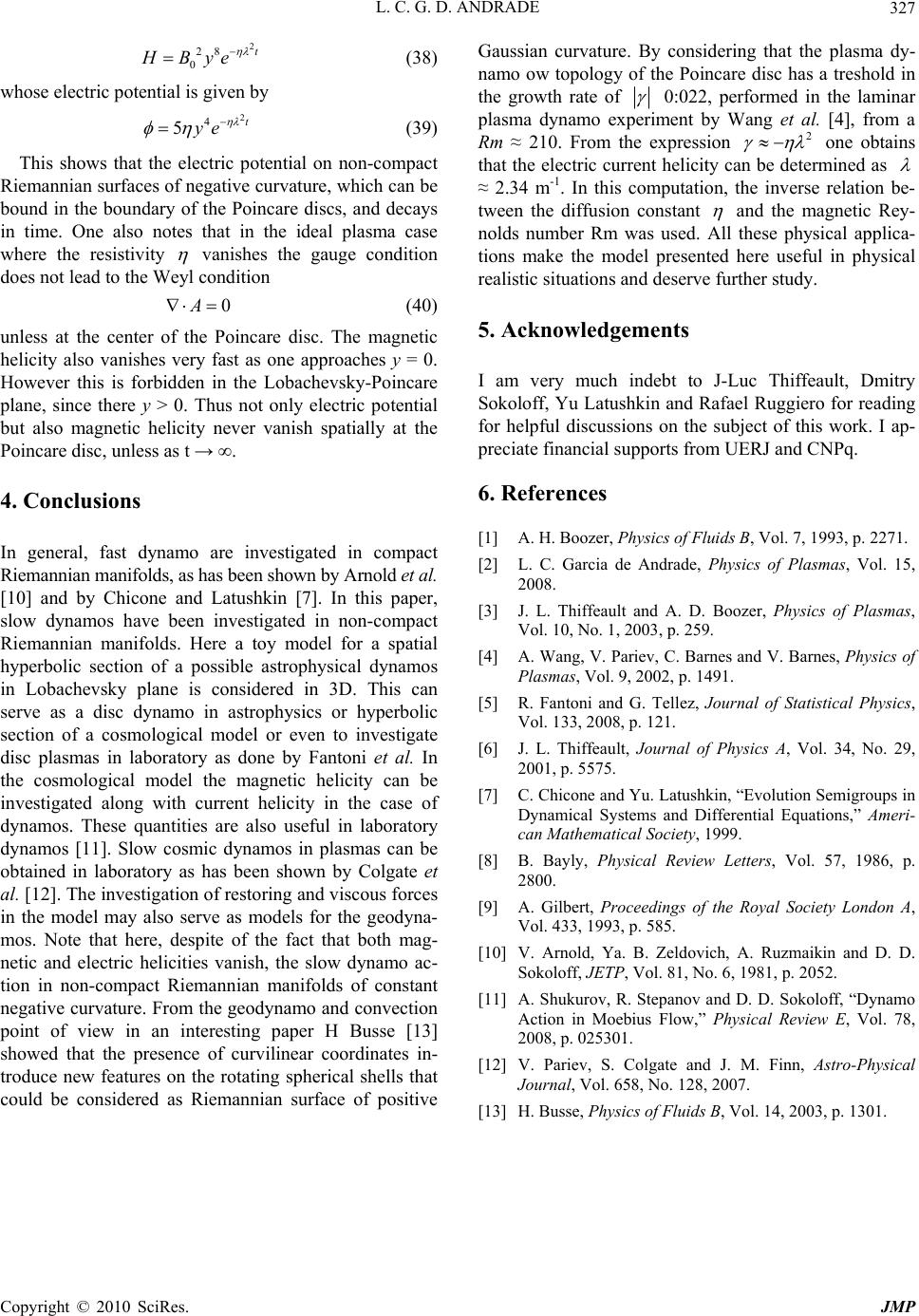Paper Menu >>
Journal Menu >>
 J. Mod. Phys., 2010, 1, 324-327 doi:10.4236/jmp.2010.15046 Published Online November 2010 (http://www.SciRP.org/journal/jmp) Copyright © 2010 SciRes. JMP Slow Plasma Dynamo Driven by Electric Current Helicity in Non-Compact Riemann Surfaces of Negative Curvature Luiz Carlos Garcia de Andrade Departamento de Fisica Teorica-IF-UERJ- RJ, Maracana, Brasil E-mail: garciluiz@gmail.com Received January 14, 2010; revised Feburary 3, 2010; accepted Feburary 1, 2010 Abstract Boozer addressed the role of magnetic helicity in dynamos [1]. He pointed out that the magnetic helicity conservation implies that the dynamo action is more easily attainable if the electric potential varies over the surface of the dynamo. This provided motivated us to investigate dynamos in Riemannian curved surfaces [2]. Thiffeault and Boozer [3] discussed the onset of dissipation in kinematic dynamos. In this paper, when curvature is constant and negative, a simple laminar dynamo solution is obtained on the flow topology of a Poincare disk, whose Gauss curvature is K = –1. By considering a laminar plasma dynamo [4] the electric current helicity λ ≈ 2.34 m–1 for a Reynolds magnetic number of Rm ≈ 210 and a growth rate of magnetic field |γ| ≈ 0.022 are obtained. Negative constant curvature non-compact H2 manifold, has also been used in onecomponent electron 2D plasma by Fantoni and Tellez [5]. Chicone et al. (CMP (1997)) showed fast dy- namos can be supported in compact H2. PACS: 47.65.Md. Keywords: Plasma, Dynamos 1. Introduction Earlier Boozer [1] has investigated magnetic helicity driven dynamos, where the magnetic helicity constraint is enhanced if the electric potential varies over surface of the dynamo. He argues that in the case of the Earth, the north-south pole variation posseses an electric potential which varies a hundred volts. Recently helicity constraints have also been investigated by Thiffeault and Boozer [3] where the dissipation is taken into account. In their case, they found that helicity generation terms are exponential smaller than energy dissipation, so that large amounts of energy are dissipated before any helicity can be created. In this paper, use is made of the Riemannian geometry of Cauchy metric in the chaotic plasma flows, where the magnetic field is stretched in the plasma flow [6]. In their case the high conducting fluid, with high magnetic Rey- nolds numbers Rm of the order 108-1015, and conse- quently very low dissipation is used. Here one addresses the converse issue and considers the case of a non-ideal plasma where the dynamo action survives on the Riemannian manifold of negative con- stant curvature in the form of a Lobachevsky plane. As it is wellknown a compact surface can be given by a torus and sphere, while noncompct srfaces can be given by paraboloids or the Lobachevski plane discussed here. This kind of negative Riemann curvature geometry in the form of a paraboloid can be easily shown to focusing the magnetic field orthogonal to its surface. It is important to stress that this does not happen in the Euclidean plane, or the spherical surface where the magnetic field lines or- thogonal to their respective surfaces remain parallel or diverge. This provides also another strong fountain of motivation for investigating the magnetic flows in geo- desic dynamos in Riemannian spaces of negative con- stant curvature. Since as shown by Chicone et al. [7] even fast dynamos can be supported in Riemannian compact 2D manifolds of constant negative curvature, the Cowling anti-fast dynamo theorem for 2D surfaces is not violated here. Anti-fast dynamo theorems have also been addressed by Garcia de Andrade [2]. The slow dynamo flows ob- tained here are shear flows, which can also be obtained by the stretch-fold-shear dynamo mechanism investi- gated previously by Bayly, Childress [8] and Gilbert [9]. In this paper the absence of advection terms is due to the presence of a comoving term which makes the spatial flow vanishes. This kind of frame is very well known in cosmology and can be used in near future to investigate cosmological dynamos. The dynamo flow used here is  L. C. G. D. ANDRADE Copyright © 2010 SciRes. JMP 325 certainly more complex that the simple uniform stretch- ing dynamo flow investigated by Arnold et al. [10]. An- other motivation for the use of negative constant Rie- mann curvature dynamo plasma surfaces, has been the one-component two-dimensional plasma by Fantoni and Tellez [5] in the realm of electron plasmas in 2D. Here, as happens in general relativity the plasma undergoes a Coriolis force which is given by the presence of the cur- vilinear coordinates effects present in the Riemann- Christoffel symbol in the MHD dynamo equation. In their non-relativistic plasma limit, this geometry has been used by Fantoni and Tellez [5] in the context of plasma physics. They have used a Flamm’s paraboloid, which is a noncompact manifold which represents the spatial Schwarzschild black hole, to investigate one- component two-dimensional plasmas. Restoring forces and magnetic field reversals possibil- ity are also discussed in 3D slow dynamo curved sur- faces. Recently another sort of slow dynamos in liquid sodium laboratory has been modelling by Shukurov at al [11], by embedding a Moebius strip flow in the three- dimensional space. The paper is organized as follows: Section 2 presents the mathematical formalism necessary to grasp the rest of the paper. In the next section the slow dynamo solution is presented as well as the non-geodesic equations is computed. In this Section 3, the sign of magnetic helicity in the exponential growth of the slow dynamo is shown to be important to the slow dynamo action. Both helicities are computed on the hyperbolic Poincare disk. Discussions and conclusions are presented in Section 4. 2. Slow Dynamo Plasmas in Curved Surfaces In the Euclidean three-dimensional space R3 described by Lobachevsky plane geometry can be presented here for the benefit of non-mathematically inclined reader. The Lobachevsky metric is given by 2222 dsy dx dy (1) where H2 = (w = x + iy; y > 0) is the hyperbolic plane in its half-upper part. Here 1i is the imaginary unit of the complex plane C. The Ricci ten Lobachevsky met- ric 11 2 1 Ry (2) 22 2 1 Ry (3) 2R (4) 12 21 22 1 y (5) 2 11 1 y (6) Riemann curvature tensor is given by 1212 4 1 Ry (7) The Kretschmann scalar invariant, so much used in GR to determine whether a singularity is not a true sin- gularity or a horizon, just in Schwarzschild black hole geometry, is given by 1212 1212 1RRR (8) which shows that the line y = 0 represents a fake singu- larity or an event horizon of the 2D section of the uni- verse. The process by which the particles are stretched in the plasma flow to give rise to dynamo, is the geodesic equation 2 2() 0 dJ KsJ ds (9) whose solution for the negative curvature hyperbolic space is 00 ()sinsin () J sJh KsJhs (10) Note that the force-free dynamo equation yields 2 ()BcurlcurlB B (11) where curlB B (12) is the force-free Beltrami equation. From the assumption that the comoving frame is used here, one obtains 0cur lVB (13) The expression for the self-induction equation is BB VB (14) where 2 is the Laplacian in general curvilinear coordinates. Therefore the calculation of this term shall be fundamental in our case. Let us expand this term in terms of Cartesian coordinates Laplacian 22 F lat xy (15) and the Riemann-Christo_el connection ,, , 1 2 iil j kljklkjjkl gg gg (16) where (i; j = 1,2,3). Now let us consider the above MHD dynamo equation in curvilinear coordinates. Since the advection term is in principle not present, our first worry should be to compute the first 1ij ij BggB g (17)  L. C. G. D. ANDRADE Copyright © 2010 SciRes. JMP 326 Here, the rate of the ampli_cation of the magnetic field from the ansatz 0()rt BBxe (18) The covariant expression for the Laplacian operator then becomes 2 ij j ij F g (19) here F is the at gradient in Cartesian (x,y) coordinates. Here : iij i j jk gTr (20) is the trace of the above Riemann-Christoffel symbol. To derive the expression (19) one used the Riemannian ge- ometry identity for the trace of Riemann-Christoffel sys- tem 1 : ii g g (21) By taking the solenoidal constraint on the magnetic field divB = 0 one obtains the form of the field as 2 0 iirt BBey (22) Note that this expression shows that, unless the y co- ordinate is bounded the magnetic field grows spatially without bounds. Since the only constraint on y is that it is positive, this certainly may be the case. If one uses the Riemann-Christo_el connections of the above Lo- bachevsky-Poincar? hyperbolic disk, one may find the first two terms in the general Laplace-Beltrami operator. By using the force-free condition above one obtains the dynamo equation as 2ii BB (23) The Maxwell magnetic two-form F is :ij ijxy z F F dxdxB dydzBdzdxB dxdy (24) where symbol means the wedge skewsymmetric product. Note that the Bz is the component of the mag- netic field orthogonal to the Lobachevsky plane. Focus- ing of the negative curvature surface magnetic field can be done by the orthogonal magnetic fields to its surface. A simple drawing of the paraboloid can show that these magnetic lines converge to some focusing point outside the paraboloid. It is easy to check that the expression (21) yields a solution for the dynamo Equation (22) as long as 2 (25) which shows that by the slow dynamo condition 0 limRe( )0 (26) Of course in fast dynamos expression (26) would be positive. Here Re represents the real part of the growth rate scalar. Note that from this expression the constraint 0 implies that either the dynamo slowliness is enhanced or the dynamo is marginal (2 = 0). This result is ob- tained since the slow dynamo criteria predominates over magnetic field decay. 3. Electric and Magnetic Helicities and Force-Free Slow Dynamos Now let us compute the electric current helicity which in the force-free dynamo case is given by 2 .jB B (27) here by Maxwell equations the electric current j is given by jB (28) From the closed two form dB = 0 of the magnetic field yields : x yz zy BAA (29) : y xz zx BAA (30) : z xy yx BAA (31) From this definition one is able to determine the elec- tric helicity and the magnetic helicity H [6] 1[.] H AB g (32) Since x yx z jAB (33) and Bx the electric helicity vanishes while the magnetic helicity can be expressed in terms of the magnetic vector potential as y xz A B (34) yields 22 0 () t x A yBeydy (35) which since the electric helicity vanishes reduces to 22 23 00 1 () 3 tt x A yBeydyBey (36) By considering that only Az and By vanish and that the gauge vector magnetic potential is given by 1 A (37) where (y,t) is the electric potential, the magnetic helicity may be computed as  L. C. G. D. ANDRADE Copyright © 2010 SciRes. JMP 327 2 28 0 t HBye (38) whose electric potential is given by 2 4 5t ye (39) This shows that the electric potential on non-compact Riemannian surfaces of negative curvature, which can be bound in the boundary of the Poincare discs, and decays in time. One also notes that in the ideal plasma case where the resistivity vanishes the gauge condition does not lead to the Weyl condition 0A (40) unless at the center of the Poincare disc. The magnetic helicity also vanishes very fast as one approaches y = 0. However this is forbidden in the Lobachevsky-Poincare plane, since there y > 0. Thus not only electric potential but also magnetic helicity never vanish spatially at the Poincare disc, unless as t → ∞. 4. Conclusions In general, fast dynamo are investigated in compact Riemannian manifolds, as has been shown by Arnold et al. [10] and by Chicone and Latushkin [7]. In this paper, slow dynamos have been investigated in non-compact Riemannian manifolds. Here a toy model for a spatial hyperbolic section of a possible astrophysical dynamos in Lobachevsky plane is considered in 3D. This can serve as a disc dynamo in astrophysics or hyperbolic section of a cosmological model or even to investigate disc plasmas in laboratory as done by Fantoni et al. In the cosmological model the magnetic helicity can be investigated along with current helicity in the case of dynamos. These quantities are also useful in laboratory dynamos [11]. Slow cosmic dynamos in plasmas can be obtained in laboratory as has been shown by Colgate et al. [12]. The investigation of restoring and viscous forces in the model may also serve as models for the geodyna- mos. Note that here, despite of the fact that both mag- netic and electric helicities vanish, the slow dynamo ac- tion in non-compact Riemannian manifolds of constant negative curvature. From the geodynamo and convection point of view in an interesting paper H Busse [13] showed that the presence of curvilinear coordinates in- troduce new features on the rotating spherical shells that could be considered as Riemannian surface of positive Gaussian curvature. By considering that the plasma dy- namo ow topology of the Poincare disc has a treshold in the growth rate of 0:022, performed in the laminar plasma dynamo experiment by Wang et al. [4], from a Rm ≈ 210. From the expression 2 one obtains that the electric current helicity can be determined as ≈ 2.34 m-1. In this computation, the inverse relation be- tween the diffusion constant and the magnetic Rey- nolds number Rm was used. All these physical applica- tions make the model presented here useful in physical realistic situations and deserve further study. 5. Acknowledgements I am very much indebt to J-Luc Thiffeault, Dmitry Sokoloff, Yu Latushkin and Rafael Ruggiero for reading for helpful discussions on the subject of this work. I ap- preciate financial supports from UERJ and CNPq. 6. References [1] A. H. Boozer, Physics of Fluids B, Vol. 7, 1993, p. 2271. [2] L. C. Garcia de Andrade, Physics of Plasmas, Vol. 15, 2008. [3] J. L. Thiffeault and A. D. Boozer, Physics of Plasmas, Vol. 10, No. 1, 2003, p. 259. [4] A. Wang, V. Pariev, C. Barnes and V. Barnes, Physics of Plasmas, Vol. 9, 2002, p. 1491. [5] R. Fantoni and G. Tellez, Journal of Statistical Physics, Vol. 133, 2008, p. 121. [6] J. L. Thiffeault, Journal of Physics A, Vol. 34, No. 29, 2001, p. 5575. [7] C. Chicone and Yu. Latushkin, “Evolution Semigroups in Dynamical Systems and Differential Equations,” Ameri- can Mathematical Society, 1999. [8] B. Bayly, Physical Review Letters, Vol. 57, 1986, p. 2800. [9] A. Gilbert, Proceedings of the Royal Society London A, Vol. 433, 1993, p. 585. [10] V. Arnold, Ya. B. Zeldovich, A. Ruzmaikin and D. D. Sokoloff, JETP, Vol. 81, No. 6, 1981, p. 2052. [11] A. Shukurov, R. Stepanov and D. D. Sokoloff, “Dynamo Action in Moebius Flow,” Physical Review E, Vol. 78, 2008, p. 025301. [12] V. Pariev, S. Colgate and J. M. Finn, Astro-Physical Journal, Vol. 658, No. 128, 2007. [13] H. Busse, Physics of Fluids B, Vol. 14, 2003, p. 1301. |

